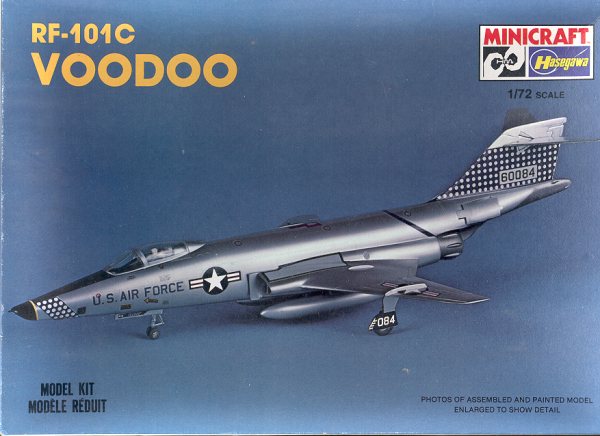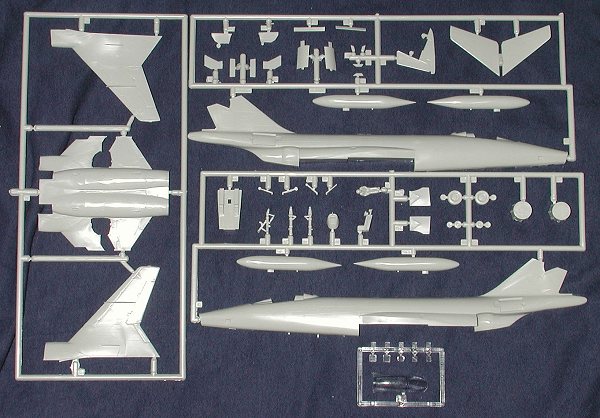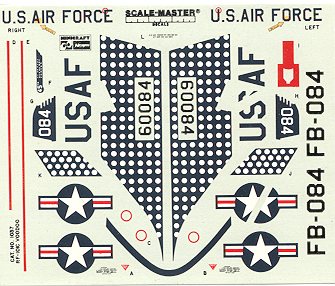
|
KIT: |
Minicraft/Hasegawa 1/72 RF-101C Voodoo |
|
KIT # |
1037 |
|
PRICE: |
$4.95 back in 1984 |
|
DECALS: |
Oneaircraft |
|
REVIEW & |
|
|
NOTES: |
` |

|
HISTORY |
The F-101 Voodoo was initially designed to be a bomber escort. As such it was built in such a way as to carry a prodigious amount of fuel for its thirsty jet engines. During the development of the aircraft, it was then decided to do several other versions. One was a twin-seat interceptor that became the F-101B. A development of the F-101A was turned into a fast recce aircraft and this was the RF-101C.
The RF-101C was not the longest lasting version, that honor going to the F-101B, however it is the only variant of the Voodoo to see combat. The USAF used the aircraft with great success in the Cuban Missile crisis to photograph Cuban SAM sites and ships bringing in medium range ballistic missiles. It was also used extensively in Vietnam to photograph targets and do post strike analysis. It relied on its speed to enter and exit the target area as the nose where the guns were normally kept were crammed with cameras. The aircraft was replaced in the USAF by the even more potent RF-4C. Those few remaining Voodoos were then passed on to ANG units, though they, too, were quickly replaced by the RF-4 or other types.
|
THE KIT |


The RF-101C is one of Hasegawa's first generation kits and one of many that was reboxed by Minicraft in the mid 1980s. As such it has all the trappings of those models. This includes very thick plastic, non-existent cockpit details, a thick single piece canopy, and raised panel lines. Detail in the wheel wells and speed brake areas is also lacking. The cockpit consists of a tub, seat and pilot. the speed brakes can be displayed open or closed. you also get a pair of external fuel tanks, something the Voodoo nearly always carried. One nice thing is that the camera windows can be installed after the fuselage is glued together, though there are no cameras to see.
Instructions are quite basic for Hasegawa consisting of four steps each with an exploded diagram. There are no interior painting instructions whatsoever so you will have to rely on references for that information. There are markings for one aircraft, an overall aluminum RF-101C from the 45th TRS. The decal sheet is well done and by Scalemaster. When not off register, the Scalemaster sheet is a big improvement over the very thick Hasegawa decals. Often, these Minicraft reboxings had exactly the same markings as the regular Hasegawa kits, though it was not always the case.
|
CONCLUSIONS |
I can tell you that it does make into a very nice model, though not up to the standards of today's kits. This is a kit I can recommend to a beginner, mostly because of the few parts and the lack of fiddlyness in construction.
Review kit courtesy of me and my wallet!
Update: Dimitriy Levin sent in this information for the most recent (2005) boxing.
The new decals cover three aircraft:
1. 56-0176 "Kathy's Clown" from 45th TRS, 460th TRW, USAF in SEA
camouflage.
2. 56-0110 from 66th TRW, USAFE in aluminum.
3. 56-0066 from 45th TRS, USAF in aluminum with polkadot nose band and
tail, similar to the Minocraft boxing.
In addition to the new markings, the decals cover more stenciling and
include decent decals for the instrument panel and the side consoles.
If you would like your product reviewed fairly and fairly quickly by a site that averages thousands of visits a day, please contact me or see other details in the Note to Contributors.